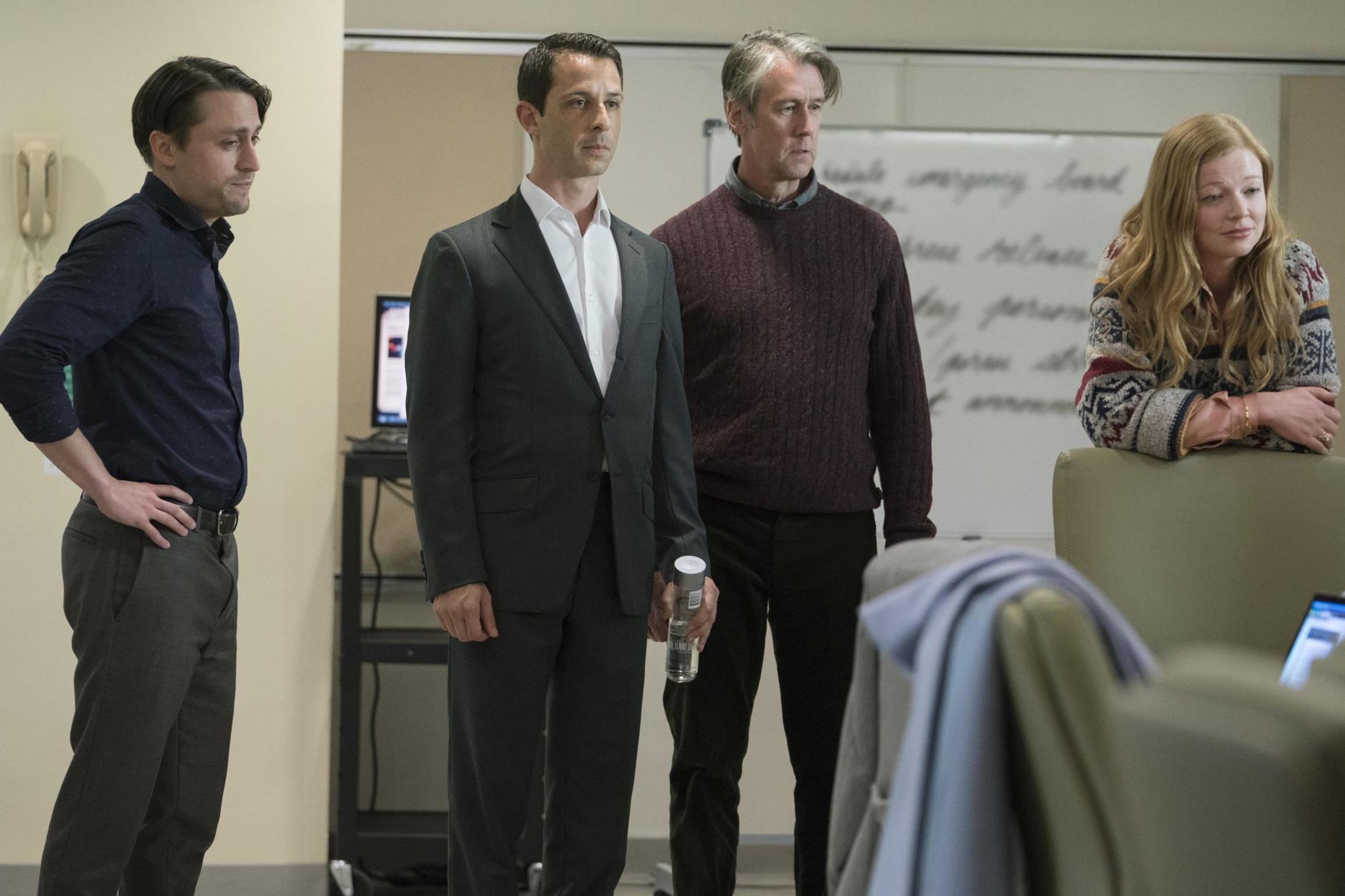Succession: Trump, Murdoch and Getty – The rich and famous families reflected in the hit series
A cut-throat family media empire fighting over wealth and power? We've heard that story before, says Clémence Michallon


Your support helps us to tell the story
From reproductive rights to climate change to Big Tech, The Independent is on the ground when the story is developing. Whether it's investigating the financials of Elon Musk's pro-Trump PAC or producing our latest documentary, 'The A Word', which shines a light on the American women fighting for reproductive rights, we know how important it is to parse out the facts from the messaging.
At such a critical moment in US history, we need reporters on the ground. Your donation allows us to keep sending journalists to speak to both sides of the story.
The Independent is trusted by Americans across the entire political spectrum. And unlike many other quality news outlets, we choose not to lock Americans out of our reporting and analysis with paywalls. We believe quality journalism should be available to everyone, paid for by those who can afford it.
Your support makes all the difference.It’s hard to watch Succession, the gilded US comedy drama about a dysfunctional media family empire, without wondering if Logan Roy’s dynasty has a real-life counterpart. The question has been part of the show’s DNA since it premiered in 2018. There are, after all, only so many ultra-rich families who could have provided a basis for the satire, and they have all made headlines – some more frequently than others.
Even a cursory glance at America’s most ludicrously wealthy suggests several potential real-life inspirations for the Roys, from the Trumps (more on them in a minute) to the Gettys, the Redstones and the Hearsts. And if you look beyond the US – and why wouldn’t you, since Logan Roy was born in Dundee, Scotland, much like Brian Cox, who portrays him – another significant name attaches itself to the list: the Murdochs.
While the Murdochs’ name is often floated as the most accurate real-life equivalent of the Roys, the family at the centre of the HBO black comedy is evidently a composite clan that shares similarities with other nouveau riche tribes. Logan, Kendall, Roman, Shiv, Greg, Tom and Marcia all seem to have been born out of various family histories and tabloid sagas.
The show’s mastermind, Peep Show creator Jesse Armstrong, previously wrote a screenplay titled Murdoch, which centered on an imagined family gathering for the media mogul’s 78th birthday. Armstrong has acknowledged that the Murdochs have been a talking point among the show’s writers (a summary of the screenplay published by Forbes in 2011 closely resembles the Succession pilot), while also bringing up several other names in an interview with Variety. “This is a fictional family,” he said of the Roys. “There’s loads of succession stories to draw on. We wanted to draw on all the good, rich stories there are about succession and about media and high politics.”
It’s worth attempting to place the show in a real-life context, if only to better inform one’s reading of what has been deemed the best show currently on TV. Here’s a breakdown of how the Roys relate to some of the most high-profile fortunes of our time.
There’s no denying that the Roys make for a pretty accurate fictional version of the Murdochs. Both families revolve around a patriarch – Logan Roy / Rupert Murdoch – and while Murdoch himself was born in Melbourne, Australia, his grandfather, the Presbyterian minister Patrick John Murdoch, is a native of Aberdeenshire, Scotland, which mirrors Logan’s origins. Naturally, both men have built media empires (Murdoch’s News Corp vs Logan’s Waystar Royco) – though Logan is understood to have grown up in relative poverty, while Murdoch was the Oxford-educated son of a local newspaper owner.
On paper, News Corp and Waystar are comparable: both are multi-billion mass media and entertainment companies, though News Corp is currently more focused on newspapers while Waystar tends to favour TV channels and the occasional digital venture (when Kendall gets involved). A corporate spin-off resulted in the 2013 creation of 21st Century Fox, News Corp’s film and TV entity, which was purchased in March 2019 by The Walt Disney Company. Disney, of course, operates a cruise line and an impressive catalogue of theme parks, similarly to – you guessed it – Waystar.
Speaking of Waystar’s cruise division, both Logan’s and Murdoch’s business empires have been marred by scandal. News Corp was a key player in the phone-hacking scandal, which led to the 2011 closure of the News of the World. Waystar, meanwhile, has cruise-ship-shaped skeletons in its closet – just ask Tom Wamsgans about the terrible crime cover-ups the division has orchestrated over the years.
Murdoch’s personal life somewhat echoes Logan’s (Murdoch has been married four times and has six children; Marcia, Logan’s spouse on the show, is his third wife, and the media mogul has three sons and one daughter), but structurally speaking, the Roy siblings are more reminiscent of another powerful family: the Trump clan.
Kendall, perhaps the most dogged of the Roy children (Shiv might disagree with this assessment), has strong Donald Trump Jr energy. The US president’s eldest child is also an executive vice-president at the Trump Organisation, his father’s conglomerate, as is Eric Trump, Don Jr’s younger sibling (remember in season one, when Kendall and Roman were respectively CEO and COO of Waystar?). A key difference, however, is Don Jr’s apparently limitless loyalty to his father. In real life, the president’s eldest has always been prompt to defend him on social media or during guest appearances on Fox News, while Kendall spends 90 per cent of his awake time (at least in season one) plotting to take down Logan and replace him at Waystar.
Of course, the Roys have plenty of political connections, mainly through Logan’s decades of endearing himself to the most powerful people in America, as well as through Shiv’s career as a political consultant. (The Trumps’ ties to the political world need either no explanation at all or way too many to fit them all here.) Shiv is a somewhat startling fictionalised version of Ivanka Trump. Both work in politics, though the former’s career tends to push her away from her father, while the latter’s is a direct result of her father’s ascent to the White House. And in a blink-and-you’ll-miss-it season one jab, one of Shiv’s brothers bitterly claims that she’s Logan’s favourite, which echoes a long-accepted status quo as to Ivanka Trump’s position in her family’s pecking order.
Cox himself drew a comparison between the Roys and the Trumps in a recent interview with the LA Times, telling the publication: “The artistic responsibility is to see it as it is, which is a morality tale. It’s about entitlement and about the time we live in. You look at Ivanka, you look at [her husband Jared] Kushner, and the fact that they are in positions which they have never been elected to. There’s nothing democratic about where they’ve come from.”
If the Trump parallels are pretty obvious for three of the four Roy siblings, they are less so for Connor. He is the only child born from Logan’s first marriage, while Kendall, Roman and Shiv were all born from his union with Caroline Collingwood, his second spouse. In that regard, Connor is in a similar situation to Tiffany Trump and her sibling Barron, born respectively from Donald Trump’s marriage to Marla Maples and Melania Trump (the Connor-Tiffany comparison has been supported by Jezebel, who painted both of them as the “kind of eccentric” children of their otherwise predictable families). Donald Jr, Eric and Ivanka, meanwhile, were all born from his union with Ivana Trump, making her the de facto Caroline Collingwood in this configuration.
While the Murdochs and the Trumps’ shadows loom rather inescapably over Succession, another family kept springing to mind as I fell further and further down a Roy-shaped rabbit hole over the course of the show’s first season: the Gettys. At first, it was hard to pinpoint why my brain kept making that connection – sure, the Gettys are very rich, as are the Roys, and like most wealthy tribes, they orbit around at least one patriarch and many children, but surely, there had to be more to the comparison. And yet, the Gettys’ family tree is more complex than the Roys’, and their fortune came from oil, not media ventures (though Mark Getty eventually co-founded the photo agency Getty Images in 1995). So why did it feel like the Gettys had left their mark on the show?
The answer came as I watched “Pre-Nuptial”, the ninth episode in the drama’s first season, when the Roys travel to England for Shiv’s wedding (scenes for the episode were shot at Eastnor Castle in Ledbury, Herefordshire). I was having flashbacks from All the Money in the World, the 2017 film about the kidnapping of John Paul Getty III in the Seventies. While rooted in America, the Getty family has strong ties to Europe, more specifically to Britain. Notably, the Minnesota-born J Paul Getty resettled in Surrey, England, and more recently, his great-granddaughter Natalia, better known as Nats Getty, moved to England as a child and attended a boarding school in Oxford (she now lives in her native Los Angeles). All this is to say, the way in which the Roys express their wealth – their tastes, their aesthetics – are much, much more redolent of the Gettys than, say, the Trumps. The Gettys’ sprawling estate in the Chilterns, Wormsley Park, which was acquired by the family in the Eighties, could conceivably have served as a wedding venue for Shiv, had Eastnor Castle not been available. The Roys might be ultra-wealthy, but rarely do they appear outwardly nouveau riche; rather, they seem to have become adept at adopting the codes of European wealth in Logan’s lifetime. Logan and Marcia’s residence in New York City, a clearly expensive yet tasteful flat, is miles away from the gaudy, gold-and-marble-decked penthouse in Trump Tower.
Because wealthy families all seem to follow similar patterns of behaviour, it’s possible to liken the Roys to some other clans, too. At the heart of Succession is the question of what should happen to the family fortune when the health of the person who amassed it begins to deteriorate, an issue faced in a very public manner by the Redstones. In 2016, a headline-making lawsuit questioned the mental competency of media magnate Sumner Redstone, in a set-up that calls to mind Kendall’s bid to launch a vote of no confidence against his father in season one (although Redstone’s lawsuit was brought by his former girlfriend Manuela Herzer). The Redstone case was dismissed in May 2016.
It’s also tempting to compare the Roys to the Hearsts, the family behind Hearst Communications (whose catalogue includes Cosmopolitan, ELLE, Marie Claire, as well as several newspapers and cable channels), or to the Maxwells (the family of British media proprietor Robert Maxwell, whose publishing empire toppled after his death in 1991). Both names have been floated by Armstrong as inspirations for Succession. Still, the Roys, as brilliantly written and realistic as they might be, remain a fictional amalgam of some of our most high-profile fortunes – and perhaps that’s for the best.
Join our commenting forum
Join thought-provoking conversations, follow other Independent readers and see their replies
Comments